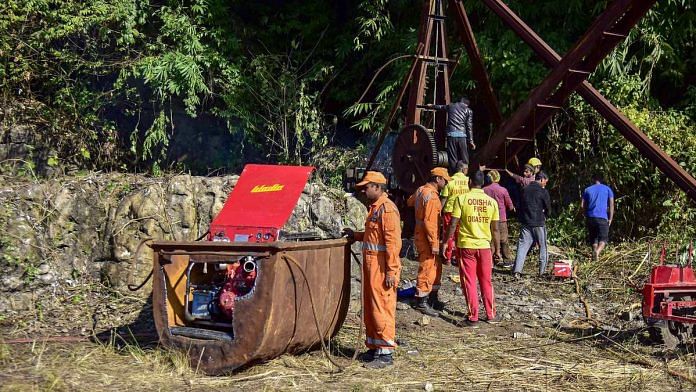A Navy diver, who is a part of the rescue operation in Meghalaya’s rat-hole coal mine, tells ThePrint about the problems being faced by the team.
New Delhi: Navy divers involved in the operation to rescue 15 miners who have been trapped in an illegal rat-hole coal mine in Meghalaya’s East Jaintia Hills since 13 December 2018, are facing an uphill task.
The miners went missing after waters from the river Lytien, which flows nearby, flooded the mine, trapping them 370 feet below the ground.
A 15-member Navy team, comprising 12 divers and other technical staff, was sent to the spot 16 days later. It’s been a difficult mission since as each mine is barely two-three-foot wide and only one diver can go in at a time.
The problem is compounded by time constraints.
A diver, who is part of the team, told ThePrint that he and the others get very limited time — between 20 and 40 minutes — once they enter the mines for the search-and-rescue effort.
“The diver, with his kit that is quite bulky, must go down till 50 metres, which is quite deep. At that depth, the diver has 20 minutes — maximum of 40 minutes — to search for the miners,” he said, throwing light on the difficulties in the extraction process.
The Supreme Court had recently directed the Centre to submit a status report by 7 January on the steps taken to rescue the miners. The diver quoted above was present in court when the matter came up for hearing last week.
According to the Professional Association of Diving Instructors (PADI), to dive at 50 metres, or about 160 feet, a diver must have logged a minimum of at least 100 dives, with at least 20 of those on a special mix of enriched air nitrox deeper than 18 metres and 15 should be deeper than 30 metres.
The challenges
According to an explainer in The Indian Express, rat-hole mining of the sort being undertaken at the East Jaintia Hills site involves digging a vertical tunnel up to 400 feet deep in search of coal seams, which are beds of the mineral that are thick enough to be profitably mined.
Once a coal seam is spotted, extremely narrow tunnels (hence, rat holes) are dug horizontally, which miners then enter to extract the coal.
At the Meghalaya accident site, waters from the Lytien have flooded the main coal pit, leaving the miners with no way out.
To explore the horizontal shafts excavated by the miners, the rescuer must go in with his head first, the diver explained to ThePrint. At that depth, it is pitch black, and so, he will need to feel around for “something soft” and come out with his feet first since there isn’t enough space to manoeuvre, he added.
Even though there is a constant supply of oxygen, a diver cannot stay at that depth for a prolonged period of time, the diver said. The deeper he goes, the less time he gets to search, he added.
Also read: These are the 15 Meghalaya miners trapped in a rat-hole coal mine
Unknown topography
During the hearing in the Supreme Court, which came up on a plea by an advocate asking for the technical wings of the Army, Navy and the Air Force to be pressed into action, Solicitor General Tushar Mehta, who was appearing for the Centre, apprised the court of the difficulties faced by the rescue personnel on site.
Mehta explained that miners sometimes go down a mine vertically and start excavating horizontally looking for coal, adding that if they do not find the coal, they start excavating further and a maze is created. “Nobody knows the map of this maze, owing to the illegality of the mine,” said Mehta.
Usually, before a company starts mining operations, it submits a blueprint of the mines, Mehta said. But, in this case, since this was an illegal mine, the blueprint was not available with the authorities, he added.
The topography of the mines was, therefore, unknown and the personnel involved in the rescue ops were working blind, Mehta added.
NGT ruling ignored
The fact that 15 lives were imperilled in an operation ruled illegal by India’s environment court, the National Green Tribunal (NGT), four years ago has only made the Meghalaya tragedy strike deeper.
The NGT order, issued on 17 April 2014, came on a clutch of pleas pointing out the dangers of rat-hole mining operations in the state.
Also read: Meghalaya miners remain trapped as high water level forces Navy to halt rescue ops






